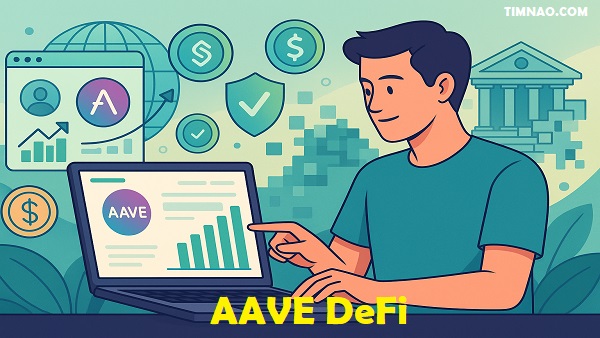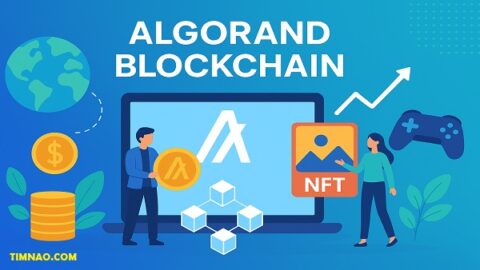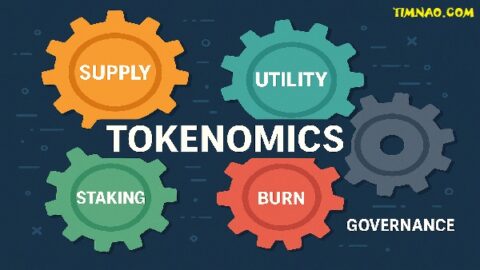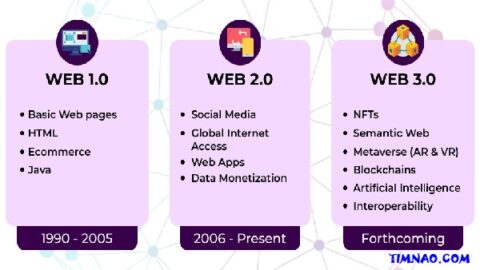🔥 Why AAVE Is Disrupting Finance Forever 🚀 — The DeFi Power Move You Can’t Ignore
AAVE DeFi is rewriting the rules of finance — and you don’t need to be a crypto expert to take part.
What started as a simple lending platform has evolved into a global financial powerhouse that lets anyone borrow, lend, and earn without middlemen. Whether you’re tired of your savings earning next to nothing at the bank, or you’re simply curious about passive income through crypto, AAVE offers an open door to a smarter, more empowering system.
In 2025, decentralized lending isn’t just a niche trend — it’s a movement. And AAVE is leading the charge with powerful tools, transparent governance, and groundbreaking features like flash loans, real-time analytics, and even NFT-backed credit.
But what exactly is AAVE? How does it work? And more importantly — how can you benefit from it safely as a beginner?
In this guide, you’ll discover everything you need to know — from setting up your first wallet, to earning passive income, to understanding AAVE’s futuristic roadmap.
📌 Table of Contents
- 💡 What Is AAVE and Why Should You Care?
- 🌐 How DeFi Is Changing the Rules of Finance
- 🧠 AAVE for Beginners: Key Concepts You Need to Know
- 🔐 Setting Up Securely: Wallets, Connections & Safety Tips
- 💸 Lending, Borrowing, and Yielding Like a Pro
- ⚙️ Flash Loans & aTokens — Unlocking AAVE’s Superpowers
- 🛡️ Keeping Your Crypto Safe: Risk & Security Essentials
- 🏦 AAVE vs Traditional Banks: What’s the Real Difference?
- 🧑⚖️ Power to the People: AAVE’s Community Governance Model
- 🖼️ NFTs Meet Finance: New Use Cases You Didn’t Expect
- 🔗 Cross-Platform Synergy: AAVE’s Expanding Ecosystem
- 📊 Making Smart Moves with AAVE Analytics
- 🚀 What the Future Holds for AAVE and DeFi
- 📷 Visualizing DeFi: Illustration Prompt
💡 What Is AAVE and Why Should You Care?
Imagine a world where you can earn passive income from your crypto without trusting a bank. Where you can borrow digital assets instantly — no paperwork, no approval process, and no human in sight. Welcome to AAVE, one of the most powerful tools in the AAVE DeFi ecosystem.
AAVE (pronounced “ah-veh”) is a decentralized protocol that lets people lend and borrow crypto directly, without relying on traditional financial institutions. It was first launched in 2017 under the name ETHLend and has since evolved into one of the most widely-used decentralized lending platforms in the world.
At its core, AAVE connects lenders and borrowers through smart contracts — self-executing lines of code running on blockchain networks like Ethereum and Polygon. Lenders deposit their crypto into shared liquidity pools and earn interest, while borrowers put up collateral to borrow from these pools.
Why Beginners Should Care
You don’t need to be a tech guru or a crypto whale to benefit from AAVE. Even with a modest investment, you can:
- Earn interest on your stablecoins and crypto assets
- Access liquidity without selling your holdings
- Avoid middlemen and control your funds at all times
- Explore advanced strategies like flash loans and liquidity mining
AAVE’s intuitive interface, wide asset support, and multi-chain accessibility make it one of the best starting points for newcomers looking to explore crypto lending and DeFi in 2025.
Whether you’re trying to grow your digital savings or unlock value from idle crypto, AAVE empowers you to make your money work — on your terms.
🌐 How DeFi Is Changing the Rules of Finance
Traditional finance is built on centralization. You deposit your money in a bank, wait days for transfers, get charged fees, and need approval to borrow your own money. In contrast, DeFi (Decentralized Finance) offers a radically different model — one that’s open, transparent, and user-driven.
Instead of relying on banks, DeFi uses blockchain technology and smart contracts to automate financial services. This means:
- ✅ No middlemen
- ✅ No business hours
- ✅ No permission required
- ✅ No borders
Anyone with an internet connection and a crypto wallet can participate.
A New Financial Playground
In the DeFi world, people are:
- Lending and borrowing instantly
- Earning passive income with stablecoins
- Participating in governance to vote on platform upgrades
- Using decentralized lending tools like AAVE to unlock cash flow
And the best part? You’re always in control.
With traditional banks, your assets are locked behind passwords, bank hours, and bureaucracy. In DeFi, you’re the sole owner of your digital wallet, and transactions settle in minutes — or seconds — without needing anyone’s approval.
Empowering the Underserved
DeFi isn’t just a new toy for crypto fans. It’s a global equalizer.
Millions of people around the world are “unbanked” — they lack access to traditional banking due to geography, politics, or income levels. With platforms like AAVE, anyone can lend, borrow, and invest — no ID, no credit check, no gatekeeping.
It’s not just about technology. It’s about financial freedom.
🧠 AAVE for Beginners: Key Concepts You Need to Know
If you’re new to the world of AAVE DeFi, don’t worry — it’s not as complex as it first seems. At its core, AAVE is just a smarter, faster, and more flexible version of what traditional banks try to do: lending and borrowing. But it works without people, paperwork, or permission.
Here are the foundational concepts every beginner needs to understand:
🔄 Liquidity Pools
Instead of banks lending out your deposits, AAVE lets users become the bank. When you deposit your crypto into AAVE, it goes into a shared liquidity pool. Borrowers then draw from that pool, and you earn interest as a reward.
It’s a win-win:
- You earn passive income by lending.
- Borrowers can access crypto by collateralizing their own holdings.
💵 Interest That Adjusts Automatically
AAVE uses algorithmic interest rates that shift in real-time based on supply and demand. If there’s a lot of borrowing, interest rates go up — giving lenders better returns. When borrowing demand drops, rates adjust accordingly.
There are two rate types you can choose from:
- Variable Rate: Moves with market demand
- Stable Rate: Fixed (but can be updated by the protocol for extreme cases)
🚀 aTokens — Your Earnings Grow Automatically
When you lend on AAVE, you receive aTokens in return (like aDAI for DAI). These tokens:
- Stay in your wallet
- Automatically accrue interest
- Can be used in other DeFi apps while still earning
No need to constantly claim your interest — it just keeps growing.
⚡ Flash Loans
This is one of AAVE’s signature features. A flash loan lets you borrow huge amounts of crypto without collateral — as long as you repay it within the same transaction block.
Flash loans are typically used for:
- Arbitrage (buying low, selling high across exchanges)
- Instant refinancing
- Complex DeFi strategies
They’re more for developers and advanced users — but they highlight how powerful and flexible decentralized lending can be.
🏛️ Governance with AAVE Tokens
Owning the AAVE token isn’t just for speculation. It gives you a vote in how the platform evolves. You can help decide:
- What assets to support
- What features to build
- How fees are structured
It’s finance driven by the people who use it — not just a boardroom.
🔐 Setting Up Securely: Wallets, Connections & Safety Tips
Before you do anything with AAVE, you’ll need a crypto wallet — and a secure setup. This is the foundation of your DeFi journey. Get it right, and you’ll avoid 90% of the mistakes that new users make.
🧳 Step 1: Choose a Wallet
Here are your best options:
| Wallet | Type | Ideal For |
|---|---|---|
| MetaMask | Browser/Mobile | Beginners and everyday DeFi use |
| Trust Wallet | Mobile | Mobile-first users and NFT holders |
| Ledger or Trezor | Hardware | Long-term holders and security-focused users |
If you’re just starting, MetaMask is the easiest to set up and works seamlessly with AAVE.
🛠️ Step 2: Create & Secure Your Wallet
When setting up your wallet:
- Back up your seed phrase (a 12 or 24-word recovery phrase)
- Never share your seed phrase with anyone
- Store it offline (not in cloud storage, notes apps, or screenshots)
Think of your seed phrase like the keys to your digital vault. If someone gets it, they control your money.
🌐 Step 3: Connect to AAVE Safely
Once your wallet is ready:
- Go to app.aave.com (bookmark it to avoid fake sites)
- Click “Connect Wallet”
- Choose your network (Ethereum, Polygon, Avalanche, etc.)
- Approve the connection
AAVE will now recognize your wallet and display available actions like Deposit, Borrow, and Stake.
🧯 Safety Tips for Every User
DeFi gives you full control — but also full responsibility. Here’s how to protect yourself:
✅ Use hardware wallets for large amounts
✅ Enable two-factor authentication on exchanges
✅ Be cautious of phishing websites — always double-check URLs
✅ Use incognito mode for transactions if you’re on shared devices
✅ Keep your wallet and browser updated
AAVE is secure — but the weakest link is often the user. Stay sharp, stay updated, and treat your crypto like real money (because it is).
💸 Lending, Borrowing, and Yielding Like a Pro
Once your wallet is set up and connected to AAVE, it’s time to unlock what makes AAVE DeFi so rewarding: the ability to lend, borrow, and earn without the restrictions of traditional banks.
Let’s break it down step-by-step.
💰 Lending: Earn Passive Income from Idle Crypto
Lending on AAVE is as simple as depositing your crypto into the protocol. In return, you start earning interest automatically — no need to lock up your funds or manage complex strategies.
Here’s how it works:
- Choose an asset (e.g., DAI, USDC, ETH)
- Click “Supply” on AAVE’s interface
- Confirm the transaction in your wallet
- Receive aTokens in return (more on that in a moment)
💡 Tip for beginners: Start with stablecoins like USDC or DAI. They earn competitive interest without the price swings of volatile tokens.
Your deposit helps power AAVE’s decentralized lending engine, and you earn yield based on demand. When borrowing increases, your interest rate increases — giving you a chance to grow your stack over time.
🧾 Borrowing: Access Funds Without Selling Your Crypto
Need liquidity but don’t want to sell your crypto? With AAVE, you can borrow against your assets. This means you keep exposure to your original investments (like ETH or LINK) while gaining access to other tokens for short-term needs or strategic plays.
How to borrow:
- Deposit crypto as collateral (e.g., 1 ETH)
- Choose the token you want to borrow (e.g., USDC)
- Pick a Stable or Variable interest rate
- Confirm the transaction
💡 Important note: AAVE uses over-collateralization. That means you’ll need to deposit more than you borrow — typically around 75% of the asset value — to protect the pool and ensure repayment.
Your health factor must stay above 1 to avoid liquidation. Monitor it closely, especially in volatile markets.
🌱 Yield Farming and Boosted Earnings
Beyond basic lending and borrowing, AAVE users can participate in liquidity mining or integrate with other DeFi protocols to boost returns.
For example:
- Deposit USDC on AAVE
- Borrow DAI
- Re-invest the borrowed DAI into another yield farm
- Repeat — carefully!
This looping strategy can multiply earnings, but it also increases risk. Make sure you understand liquidation thresholds and always use low-volatility assets when starting out.
⚙️ Flash Loans & aTokens — Unlocking AAVE’s Superpowers
AAVE is more than just a lending platform. It’s a toolkit of powerful financial instruments that make traditional finance look slow and outdated.
Let’s explore two of its most innovative features.
⚡ Flash Loans: Borrow Without Collateral (Seriously)
Flash loans are a mind-blowing feature of the AAVE protocol. They let you borrow an unlimited amount of crypto without any collateral, as long as you repay the loan within the same transaction block.
This means you can:
- Arbitrage price differences between exchanges
- Instantly refinance loans
- Execute multi-step trades in a single transaction
Example:
A trader sees ETH priced at $1,850 on Exchange A and $1,880 on Exchange B. They:
- Use a flash loan to borrow ETH from AAVE
- Buy on Exchange A and sell on Exchange B
- Repay the loan instantly — and keep the profit
All of this happens automatically through a smart contract — with zero upfront capital.
💡 Note: Flash loans are advanced tools, often used by developers and arbitrage traders. If you’re just starting out, it’s better to observe and learn before attempting one.
🪙 aTokens: Your Interest-Earning Crypto Clones
Whenever you supply crypto to AAVE, you receive a mirrored token called an aToken — like aUSDC for USDC or aDAI for DAI.
These aTokens are the secret to your earnings:
- Their balance grows automatically in your wallet as you earn interest
- You can use them in other DeFi apps — expanding your passive income opportunities
- They’re pegged 1:1 to the underlying asset (1 aDAI = 1 DAI)
You don’t need to manually claim interest — your aTokens do all the work. It’s like owning a savings account that grows 24/7, with zero maintenance.
🔑 Why This Matters for Beginners
Most beginners think DeFi is just about buying tokens and watching charts. But AAVE flips the script. With just a few steps, anyone can:
- Turn idle crypto into interest-earning assets
- Access funding without selling your holdings
- Explore smart tools like aTokens and flash loans
- Gradually learn the ropes of decentralized lending
Even small deposits can teach you the flow of Web3 finance.
🛡️ Keeping Your Crypto Safe: Risk & Security Essentials
While AAVE DeFi opens up a world of opportunities, it also comes with responsibilities. In the world of decentralized lending, you are your own bank — and that means you’re in charge of your own security.
Understanding the risks and how to mitigate them is essential, especially for beginners.
⚠️ The Risks You Should Know
Even though AAVE is one of the most secure DeFi platforms, here are some risks to be aware of:
- Smart Contract Bugs
Although AAVE’s code is audited, vulnerabilities can exist — and once exploited, the damage can be instant. - Market Volatility
Crypto prices can swing wildly. If your collateral value drops, you risk liquidation. - Liquidation Risk
AAVE uses a Health Factor to monitor your loans. If it drops below 1, your assets may be automatically sold to repay the loan. - Phishing Attacks
Fake websites and scam DApps can trick you into revealing your wallet or private keys. - User Error
Unlike banks, there’s no support line if you send tokens to the wrong address or lose your wallet credentials.
🧰 How to Protect Yourself
Here’s a checklist every beginner should follow before interacting with crypto lending protocols like AAVE:
✅ Use hardware wallets (Ledger or Trezor) for long-term holdings
✅ Bookmark AAVE’s official app: app.aave.com — don’t trust search results
✅ Double-check wallet permissions before confirming transactions
✅ Enable 2FA on your email and crypto exchange accounts
✅ Keep software and browser extensions updated
✅ Avoid public Wi-Fi when accessing your wallet
💡 Pro Tip: Use tools like Revoke.cash to manage and revoke wallet permissions granted to DeFi apps.
🛡️ AAVE’s Safety Net: The Safety Module
AAVE has a built-in protection system called the Safety Module. This is a pool of AAVE tokens staked by users to backstop the protocol in extreme cases, like smart contract failures or liquidity shortages.
If something goes wrong, up to 30% of the Safety Module can be used to cover shortfalls — giving users an extra layer of security.
🏦 AAVE vs Traditional Banks: What’s the Real Difference?
It’s easy to compare AAVE to a digital bank — but the truth is, it’s much more than that. AAVE flips the script on how we think about lending, borrowing, and saving.
Here’s how AAVE stacks up against traditional banks:
| Feature | AAVE DeFi | Traditional Banks |
|---|---|---|
| Access | Global, 24/7 | Regional, business hours |
| Control | User owns funds | Bank holds custody |
| Lending | Instant & permissionless | Requires credit checks |
| Transparency | 100% on-chain | Limited access to internal processes |
| Interest Rates | Dynamic, based on demand | Predetermined, often lower |
| Innovation | Flash loans, tokenized interest | Slow to evolve |
| Identity Requirement | None (pseudonymous) | Requires full KYC/ID |
| Governance | Community-driven | Corporate/central authority |
🌍 Why This Matters in 2025
Banks are useful, but limited — especially for people in regions with:
- High fees
- Unstable currencies
- Restricted access to credit
Platforms like AAVE offer a borderless alternative where anyone can lend, borrow, and earn with just a smartphone and internet connection.
In countries where inflation erodes savings or where people can’t qualify for loans, decentralized lending offers hope and opportunity.
And in developed nations? AAVE is attracting tech-savvy users who are tired of 0.01% interest on their savings and want to be part of the future of finance.
🧑⚖️ Power to the People: AAVE’s Community Governance Model
In traditional finance, decisions happen behind closed doors — in boardrooms, among executives, and usually without input from the public. But AAVE DeFi turns this model upside down. With AAVE, the users are in charge.
This is made possible through community governance — a decentralized decision-making system where anyone who holds the AAVE token can help shape the future of the protocol.
🗳️ How AAVE Governance Works
AAVE’s governance system is powered by smart contracts and on-chain voting. Here’s how it works in practice:
- Hold AAVE tokens or stkAAVE (staked AAVE) to gain voting power
- Propose or vote on protocol changes, like adding new assets or adjusting interest models
- Governance proposals are transparent, time-locked, and publicly recorded
- If approved, the smart contract executes changes without needing a centralized authority
It’s democracy on the blockchain.
This model ensures that upgrades and decisions reflect the will of the community — not a company or founder. Whether you’re a whale or a smallholder, your voice can influence AAVE’s evolution.
🎯 What Can You Vote On?
A few examples of what AAVE’s community can vote on:
- Which new tokens should be added for crypto lending
- Risk parameters and loan-to-value (LTV) ratios
- Treasury management and fund allocation
- Safety Module updates and ecosystem grants
AAVE’s open governance makes it not just a platform — but a living financial system that grows and evolves with its users.
🖼️ NFTs Meet Finance: New Use Cases You Didn’t Expect
Most people associate NFTs (non-fungible tokens) with digital art and collectibles — things like CryptoPunks, Bored Apes, or profile pictures. But in 2025, NFTs are entering the DeFi space in a big way — and AAVE is helping to shape this movement.
🧩 Tokenizing Real Value
Through integrations with projects like JPEG’d and Astaria, AAVE users can now use NFTs as collateral for loans. This means your valuable NFTs are no longer just digital trophies — they become liquid financial assets.
Example use case:
- You own a rare Bored Ape NFT valued at $80,000
- Instead of selling it, you deposit it as collateral
- You receive a stablecoin loan (e.g., USDC) without losing ownership
- You can use that liquidity while keeping exposure to the NFT’s potential value growth
It’s like getting a loan on your home — except your “home” is a digital asset, and the process is instant, global, and permissionless.
🧠 Why This Matters
This innovation:
- Gives artists and collectors more financial flexibility
- Creates a new way to monetize digital identity and ownership
- Expands the scope of decentralized lending far beyond standard tokens
NFT-collateralized lending is still in its early days, but the ecosystem is growing rapidly. It opens up powerful use cases not just for individuals, but also for businesses and DAOs holding large NFT treasuries.
🔄 Fractionalized NFTs & DeFi Liquidity
A new trend is also emerging: fractionalized NFTs.
Platforms are beginning to break down high-value NFTs into smaller, tradable tokens. These can then be used in DeFi — including staking, lending, and earning yield, just like traditional tokens.
This means that even if you can’t afford a full NFT, you can still own a piece — and benefit from DeFi utilities tied to it.
🔗 Cross-Platform Synergy: AAVE’s Expanding Ecosystem
AAVE started on Ethereum — but it hasn’t stayed there. As DeFi continues to grow, AAVE has become one of the most cross-compatible protocols in the ecosystem, making it easier than ever for users to access decentralized lending from multiple blockchains.
This isn’t just about convenience — it’s about opportunity.
🌐 Multi-Chain Magic
AAVE is now deployed on a variety of leading blockchains, including:
- Polygon (low fees and fast transactions)
- Avalanche (high-speed, eco-friendly chain)
- Arbitrum & Optimism (Ethereum Layer 2 networks)
- Base by Coinbase (a rising star with massive potential)
- Gnosis Chain, Metis, and others
Each chain offers different advantages — from lower fees to faster speeds to ecosystem-specific incentives. As a user, you’re free to choose where and how to interact with AAVE.
💡 Tip: New chains often come with higher yield incentives to attract liquidity — perfect for beginners looking to experiment with small deposits.
🧱 Interoperability Is the Future
AAVE’s strength lies in its ability to work with other DeFi platforms seamlessly.
Examples of integrations:
- Balancer and Curve: Create high-yield liquidity pools
- Chainlink: Delivers real-time, decentralized price feeds
- Yearn Finance: Uses AAVE to automate yield optimization
- Paraswap: Enables one-click token swaps inside the AAVE interface
This “plug-and-play” model is turning AAVE into a core layer of Web3 finance. Rather than operating as a standalone tool, it’s becoming the foundation upon which many DeFi strategies are built.
📊 Making Smart Moves with AAVE Analytics
Whether you’re lending stablecoins, borrowing ETH, or experimenting with NFT-collateralized loans, one thing is certain: data is power. And AAVE provides plenty of it — if you know where to look.
Understanding and using AAVE’s analytics tools can help you:
- Spot trends
- Time your entries and exits
- Manage risks
- Maximize returns
📈 Real-Time Data, Real Results
AAVE’s official interface includes a Dashboard that gives you:
- Real-time interest rates (supply and borrow)
- Total value locked (TVL)
- Utilization ratios (how much of each pool is being borrowed)
- Health factor tracking for your loans
- Market overviews across chains
You can access this at: app.aave.com/dashboard
But that’s just the beginning.
🔍 Third-Party Tools for Deeper Insight
For users who want more in-depth data, several powerful tools integrate with AAVE:
| Tool | What It Does |
|---|---|
| DeFiLlama | Tracks total value locked and AAVE rankings across chains |
| Dune Analytics | Custom dashboards for loan volume, liquidation data, protocol activity |
| Zapper | Portfolio tracking and cross-platform DeFi management |
| Debank | View all your AAVE positions across chains in one interface |
| Revoke.cash | Manage and revoke token approvals for better wallet security |
💡 Pro tip: Check utilization rate before lending. A higher rate often means higher interest — but also higher risk of liquidity shortages.
📉 Protecting Yourself with Analytics
Analytics aren’t just for maximizing profits — they also help prevent losses.
For example:
- Monitoring your Health Factor can prevent sudden liquidations
- Watching interest rate spikes can help you switch from variable to stable loans
- Tracking total liquidity on a given chain can warn you before markets tighten
In short, the more informed you are, the smarter your moves — and the more confidently you can explore the world of crypto lending.
🚀 What the Future Holds for AAVE and DeFi
AAVE isn’t just evolving — it’s leading the way forward in DeFi innovation. What started as a simple crypto lending platform has grown into a multi-chain, multi-asset, and multi-functional powerhouse. But what’s next?
Let’s take a glimpse into AAVE’s expanding frontier.
🌎 Real-World Assets (RWAs) on the Blockchain
AAVE has already begun exploring the tokenization of real-world assets, like:
- Real estate-backed loans
- Tokenized bonds and treasury bills
- On-chain credit markets for businesses
By bridging traditional finance with blockchain, decentralized lending becomes accessible to both Web3 users and real-world institutions — a massive leap toward mainstream adoption.
Projects like Centrifuge and Maple Finance are already integrating with AAVE to bring these real-world asset pools to DeFi users.
🧩 AAVE V4 — The Next Evolution
AAVE’s upcoming V4 upgrade, expected in late 2025, will bring major enhancements:
- Intent-based architecture (smarter trade routing)
- Unified liquidity layers across chains
- Native support for cross-chain borrowing
- Improved risk engine and oracle resiliency
- Expanded integration with real-world identity providers
This positions AAVE as a foundational layer of Web3 finance, seamlessly connecting decentralized and centralized systems.
👥 Social & Community Finance
New frontiers like social lending circles, on-chain credit scores, and decentralized identity are being tested within the AAVE ecosystem.
Imagine a world where:
- Your social rep (not just your wallet) boosts your borrowing power
- You can co-lend with trusted communities
- You’re rewarded for reputation, not just collateral
These innovations are aligned with AAVE’s mission of building inclusive financial tools for everyone.
🏛️ Navigating Regulation
As regulators begin focusing more on DeFi, AAVE is actively participating in compliance discussions. Expect to see:
- Permissioned pools for institutional clients
- KYC-enabled interfaces for certain jurisdictions
- Legal frameworks that protect users while preserving decentralization
Rather than fight regulation, AAVE is working to shape it, building tools that meet global standards without compromising user sovereignty.
🙋 FAQs: Beginner Questions About AAVE DeFi Answered
Q1: Do I need a lot of money to use AAVE?
No! You can start with just a few dollars. Platforms like Polygon and Arbitrum offer low-fee environments perfect for beginners testing crypto lending with small amounts.
Q2: Can I lose my money on AAVE?
Yes, DeFi carries risk. Market crashes, liquidation events, or smart contract bugs can result in losses. Always research, monitor your Health Factor, and never invest more than you can afford to lose.
Q3: Is AAVE better than a bank?
In many ways, yes — especially for flexibility, control, and yield. But AAVE isn’t insured like a traditional bank. It’s best viewed as a powerful alternative, not a direct replacement.
Q4: How fast can I withdraw my crypto?
Instantly. As long as there’s liquidity in the pool, you can withdraw at any time. No waiting for approvals or office hours.
Q5: Is AAVE safe to use on mobile?
Yes, if you’re using a trusted wallet like MetaMask Mobile or Trust Wallet. Always double-check app URLs and avoid public Wi-Fi when interacting with your crypto.
Q6: Do I pay taxes on AAVE earnings?
Yes, in most countries, interest from decentralized lending is considered taxable income. Always consult your local tax advisor to stay compliant.
🎯 Final Thoughts: Your DeFi Journey Starts Here
AAVE is more than just a protocol — it’s a gateway to financial empowerment in the digital age.
With it, you can:
- Earn passive income on your crypto
- Borrow without banks
- Explore the cutting edge of finance
- Contribute to a global community shaping the future
Whether you’re a cautious beginner or a curious explorer, AAVE offers a safe, powerful entry point into the world of AAVE DeFi and crypto lending. Start small, stay informed, and let your money work smarter — on your terms.
📜 Disclaimers
Not Financial Advice:
The information provided in this article is for educational and informational purposes only. It should not be considered financial, investment, or trading advice. Always do your own research and consult with a licensed financial advisor before making any investment decisions.
Crypto Investment Risks:
Cryptocurrency markets are highly volatile and can carry significant risks. The use of DeFi platforms like AAVE involves smart contract risk, market risk, and protocol-specific risks. Users should only invest what they can afford to lose.
No Guarantees:
While AAVE and other DeFi platforms offer promising features, returns are never guaranteed. Past performance is not indicative of future results. Interest rates and lending conditions can change rapidly.
Third-Party Tools:
This article may include links to third-party tools and platforms. We are not responsible for the accuracy, security, or reliability of any external services mentioned. Please use all tools and platforms at your own discretion.
Jurisdictional Considerations:
Access to and usage of DeFi protocols like AAVE may be subject to legal restrictions depending on your jurisdiction. Ensure you are compliant with your local laws and regulations before engaging with DeFi platforms.









